A Laboratory Study of the Effects of Interbeds on Hydraulic Fracture Propagation in Shale Formation
Abstract
:1. Introduction
2. Laboratory Experiment Design
2.1. Basis of Model Block Preparation
2.2. Model Block Preparation
2.3. Experimental Setup
2.4. Experiment Conditions
3. Experimental Results and Analysis
3.1. Pump Pressure-Injection Time Curve
- (a)
- the fracturing fluid is injected and pumped;
- (b)
- the pump pressure increases and initial fractures generate;
- (c)
- the pumping pressure continues to increase and fractures propagate, until the pressure rises to the highest point; and
- (d)
- fractures extend within the model block and fracturing fluid filtrates into fractures, then pressure drops.
3.2. Effects of the Thickness of Interbeds on Fracture Propagation
3.3. Effects of the Strength of Interbedson Fracture Propagation
4. Conclusions
- (1)
- Pump pressure-injection time curves of the five model blocks were obtained under the same in-situ stress field and flow rate. The breakdown pressure increases with the decrease of the thickness and strength of interbeds. The cause of this result is that higher force is required to break the block with thick and high strength interbeds.
- (2)
- The main fracture has difficulty in crossing the interbeds of thick and high strength, and is prone to divert along the bedding faces. On the surfaces, the model block with lower strength interbeds could generate longer fracture, and the model block with thinner interbeds tends to produce more branches along the main fracture, which forms a complex fracture network.
- (3)
- Both visible and micro-fractures can be observed on the main fracture planes by the microscope, but most fractures are tiny. The model block with thinner and lower strength interbeds tends to produce more fractures and the width of the visible fractures is relatively larger on the main fracture planes. Further experiments and simulation studies are needed to reveal the mechanism of fracture propagation in shales.
Acknowledgments
Author Contributions
Conflicts of Interest
References
- Yadav, H. Hydraulic Fracturing in Naturally Fractured Reservoirs and the Impact of Geomechanics on Microseismicity. Master’s Thesis, The University of Texas at Austin, Austin, TX, USA, December 2011. [Google Scholar]
- Blanton, T.L. Propagation of hydraulically and dynamically induced fractures in naturally fractured reservoirs. In Proceedings of the Society of Petroleum Engineers Unconventional Gas Technology Symposium, Louisville, KY, USA, 18–21 May 1986.
- Beugelsdijk, L.J.L.; De Pater, C.J.; Sato, K. Experimental hydraulic fracture propagation in a multi-fractured medium. In Proceedings of the Society of Petroleum Engineers Asia Pacific Conference on Integrated Modelling for Asset Management, Yokohama, Japan, 25–26 April 2000.
- Olson, J.E.; Bahorich, B.; Holder, J. Examining hydraulic fracture-natural fracture interaction in hydrostone block experiments. In Proceedings of the Society of Petroleum Engineers Hydraulic Fracturing Technology Conference, The Woodlands, TX, USA, 6–8 February 2012.
- Bahorich, B.; Olson, J.E. Examining the effect of cemented natural fractures on hydraulic fracture propagation in hydrostone block experiments. In Proceedings of the Society of Petroleum Engineers Annual Technical Conference and Exhibition, San Antonio, TX, USA, 8–10 October 2012.
- Sarmadivaleh, M. Experimental and Numerical Study of Interaction of a Pre-Existing Natural Interface and an Induced Hydraulic Fracture; Curtin University: Perth, Australia, 2012. [Google Scholar]
- Wang, Y.; Li, X.; Hu, R.L.; Ma, C.F.; Zhao, Z.H.; Zhang, B. Numerical evaluation and optimization of multiple hydraulically fractured parameters using a flow-stress-damage coupled approach. Energies 2016, 9, 325. [Google Scholar] [CrossRef]
- Warpinski, N.R.; Fnley, S.J.; Vollendorf, W.C.; O’Brien, M.; Eshom, E. The Interface Test Series: An In Situ Study of Factors Affecting the Containment of Hydraulic Fractures; Sandia National Laboratories Report SAND81-2408; Sandia National Laboratories: Albuquerque, NM, USA, February 1982. [Google Scholar]
- Warpinski, N.R.; Teufel, L.W. Influence of Geologic Discontinuities on Hydraulic Fracture Propagation. J. Pet. Technol. 1987, 39, 209–220. [Google Scholar] [CrossRef]
- Sarmadivaleh, M.; Rasouli, V. Test Design and Sample Preparation Procedure for Experimental Investigation of Hydraulic Fracturing Interaction Modes. Rock Mech. Rock Eng. 2015, 48, 93–105. [Google Scholar] [CrossRef]
- Ishida, T.; Chen, Q.; Mizuta, Y.; Roegiers, J.C. Influence of fluid viscosity on the hydraulic fracturing mechanism. Energy Resour. Technol. 2004, 126, 190–200. [Google Scholar] [CrossRef]
- Inui, S.; Ishida, T.; Nagaya, Y.; Nara, Y.; Chen, Y. AE monitoring of hydraulic fracturing experiments in Granite blocks using supercritical CO2, water and viscous oil. In Proceedings of the 48th US Rock Mechanics/Geomechanics Symposium, Minneapolis, MN, USA, 1–4 June 2014.
- Lhomme, T.P.; De Pater, C.J.; Helfferich, P.H. Experimental study of hydraulic fracture initiation in Colton sandstone. In Proceedings of the SPE/ISRM Rock Mechanics Conference, Irving, TX, USA, 20–23 October 2002.
- Meng, C.; De Pater, H.J. Hydraulic propagation in pre-fractured natural rocks. In Proceedings of the Society of Petroleum Engineers Hydraulic Fracturing Technology Conference, The Woodlands, TX, USA, 24–26 January 2011.
- Van Eekelen, H.A.M. Hydraulic fracture geometry: fracture containment in layered formations. Soc. Petrol. Eng. J. 1982, 22, 341–349. [Google Scholar] [CrossRef]
- Wang, Y.H.; Fu, H.F.; Liang, T.C.; Wang, X.; Liu, Y.Z.; Peng, Y.; Yang, L.F.; Tian, Z.H. Large-scale physical simulation experiment research for hydraulic fracturing in shale. In Proceedings of the Society of Petroleum Engineers Middle East Oil & Gas Show and Conference, Manama, Bahrain, 8–11 March 2015.
- Curtis, J.B. Fractured shale-gas systems. AAPG Bull. 2002, 86, 1921–1938. [Google Scholar]
- Zhang, J.C.; Jin, Z.Y.; Yuan, M.S. Reservoiring mechanism of shale gas and its distribution. Nat. Gas Ind. 2004, 5, 12–14. [Google Scholar]
- Zeng, W.T.; Zhang, J.C.; Ding, W.L. The Gas content of continental Yanchang Shale and its main controlling factors: A case study of liuping-171 well in Ordos Basin. Nat. Gas Geosci. 2014, 2, 291–301. [Google Scholar]
- Liu, X.J.; Xiong, J.; Liang, L.X. Investigation of pore structure and fractal characteristics of organic-rich Yanchang formation shale in central China by nitrogen adsorption/desorption analysis. J. Nat. Gas Sci. Eng. 2015, 22, 62–67. [Google Scholar] [CrossRef]
- Lei, Y.H.; Luo, X.R.; Wang, X.Z.; Zhang, L.X.; Jiang, C.F.; Yang, W.; Yu, W.X.; Cheng, M.; Zhang, L.K. Characteristics of silty laminae in Zhangjiatan Shale of southeastern Ordos Basin, China: Implications for shale gas formation. AAPG Bull. 2015, 4, 661–687. [Google Scholar] [CrossRef]
- Liu, Q.Y.; Jin, Z.J.; Wang, Y.; Han, P.L.; Tao, Y.; Wang, Q.C.; Ren, Z.L.; Li, W.H. Gas filling pattern in Paleozoic marine carbonate reservoir of Ordos Basin. Acta Petrol. Sin. 2012, 28, 847–858. [Google Scholar]
- Tang, X.; Zhang, J.; Shan, Y.; Xiong, J. Upper Paleozoic coal measures and unconventional natural gas systems of the Ordos Basin. Chin. Geosci. Front. 2012, 3, 863–873. [Google Scholar] [CrossRef]
- Luo, P.; Ji, L.M. Reservoir characteristics and potential evalution of continental shale gas. Nat. Gas Geosci. 2013, 5, 1060–1068. [Google Scholar]
- Tang, X.; Zhang, J.C.; Wang, X.Z.; Yu, B.S.; Ding, W.L.; Xiong, J.Y.; Yang, Y.T.; Wang, L.; Yang, C. Shale characteristics in the southeastern Ordos Basin, China: Implications for hydrocarbon accumulation conditions and the potential of continental shales. Int. J. Coal Geol. 2014, 128–129, 32–46. [Google Scholar] [CrossRef]
- Xu, D.; Hu, R.L.; Gao, W.; Xia, J.G. Effects of laminated structure on hydraulic fracture propagation in shale. Petrol. Explor. Dev. 2015, 4, 573–579. [Google Scholar] [CrossRef]
- De Pater, C.J.; Beugelsdijk, L.J.L. Experimental and numerical simulation of hydraulic fracturing in naturally fractured rock. In Proceedings of the 40th U.S. Symposium on Rock Mechanics of Alaska Rocks, Anchorage, AK, USA, 25–29 June 2005.
- Wang, W. Numerical Simulation and Experimental Research on the Oil Shale Hydraulic Fracturing; Jilin University: Changchun, China, 2014. [Google Scholar]
- Zhao, D.A.; Chen, Z.M.; Cai, X.L.; Li, S.Y. Analysis of distribution rule of geostress in China. Chin. J. Rock Mech. Sand Eng. 2007, 6, 1265–1271. [Google Scholar]
- Adachi, J.I. Fluid-Driven Fracture in Impermeable and Permeable Rock. Ph.D. Thesis, University of Minnesota, Minneapolis, MN, USA, 2001. [Google Scholar]
- De Pater, C.J.; Cleary, M.P.; Quinn, T.S.; Barr, D.T.; Johnson, D.E.; Weijers, L. Experimental verification of dimensional analysis for hydraulic fracturing. Soc. Petrol. Eng. 1994, 4, 230–238. [Google Scholar] [CrossRef]
- Berchenko, I.; Detournay, E.; Chandler, N.; Martino, J. An in-situ thermo-hydraulic experiment in a saturated granite I: Design and results. Int. J. Rock Mech. Min. Sci. 2004, 41, 1377–1394. [Google Scholar] [CrossRef]
- Jeffrey, R.G.; Byrnes, R.P.; Lynch, P.A.; Ling, D.J. An analysis of hydraulic fracture and mineback data for a treatment in the German creek coal seam. In Proceedings of the Society of Petroleum Engineers Rocky Mountain Regional Meeting, Casper, WY, USA, 18–21 May 1992.
- Ishida, T.; Niwa, T.; Aoyagi, K.; Yamakawa, A.; Chen, Y.; Fukahori, D.; Murata, S.; Chen, Q.; Nakayama, Y. AE monitoring of hydraulic fracturing laboratory experiment with supercritical and liquid state CO2. In Proceedings of the 2012 ISRM international Symposium, Stockholm, Sweden, 28–30 May 2012.
- Warpinski, N.R.; Branagan, P.T.; Peterson, R.E.; Wolhart, S.L. An interpretation of M-site hydraulic fracture diagnostic results. In Proceedings of the Society of Petroleum Engineers Rocky Mountain Regional/Low-Permeability Reservoirs Symposium, Denver, CO, USA, 5–8 April 1998.
- Wright, C.A.; Weijers, L.; Davis, E.J.; Mayerhofer, M. Understanding hydraulic fracture growth: Tricky but not hopeless. In Proceedings of the Society of Petroleum Engineers Annual Technical Conference and Exhibition, Houston, TX, USA, 3–6 October 1999.

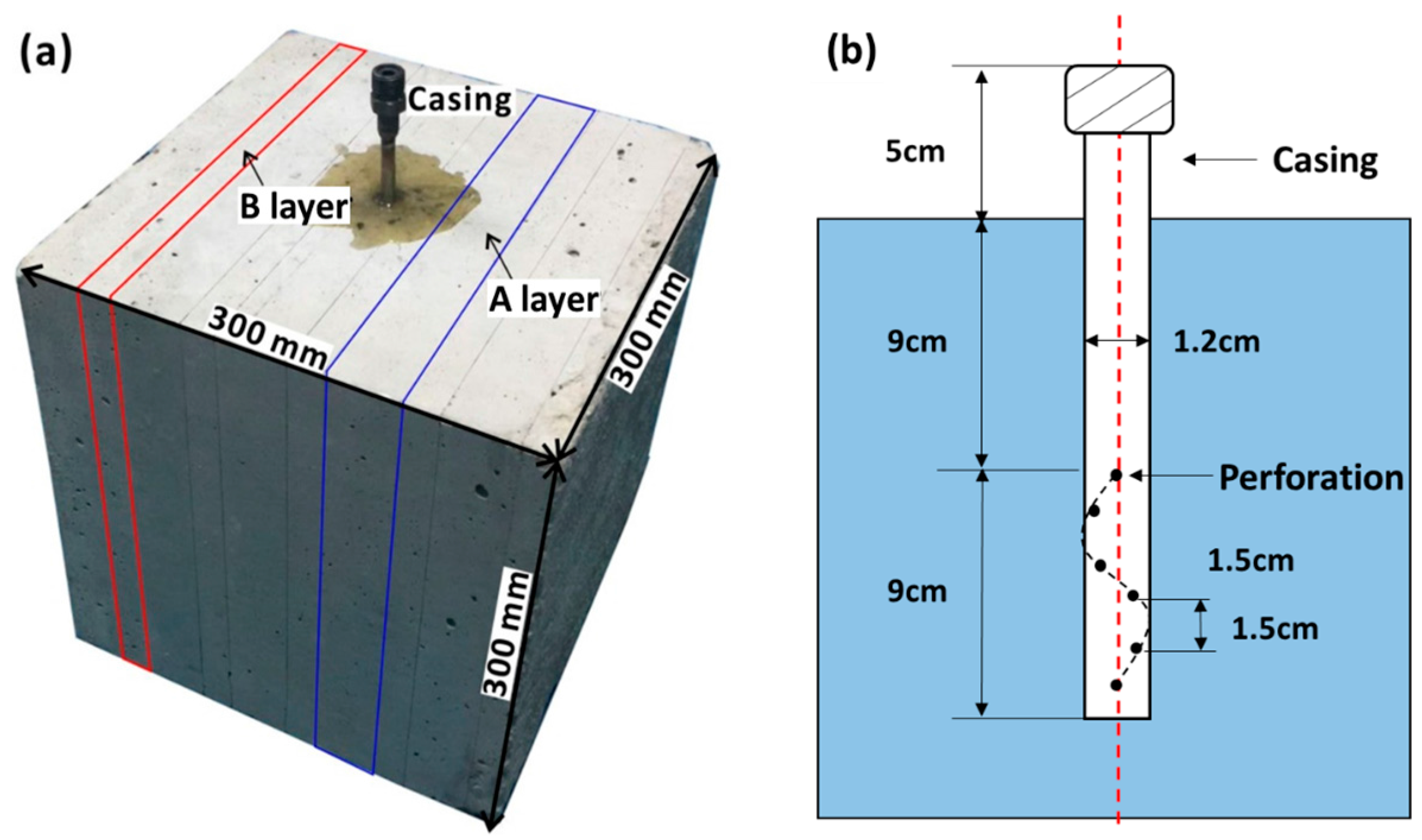
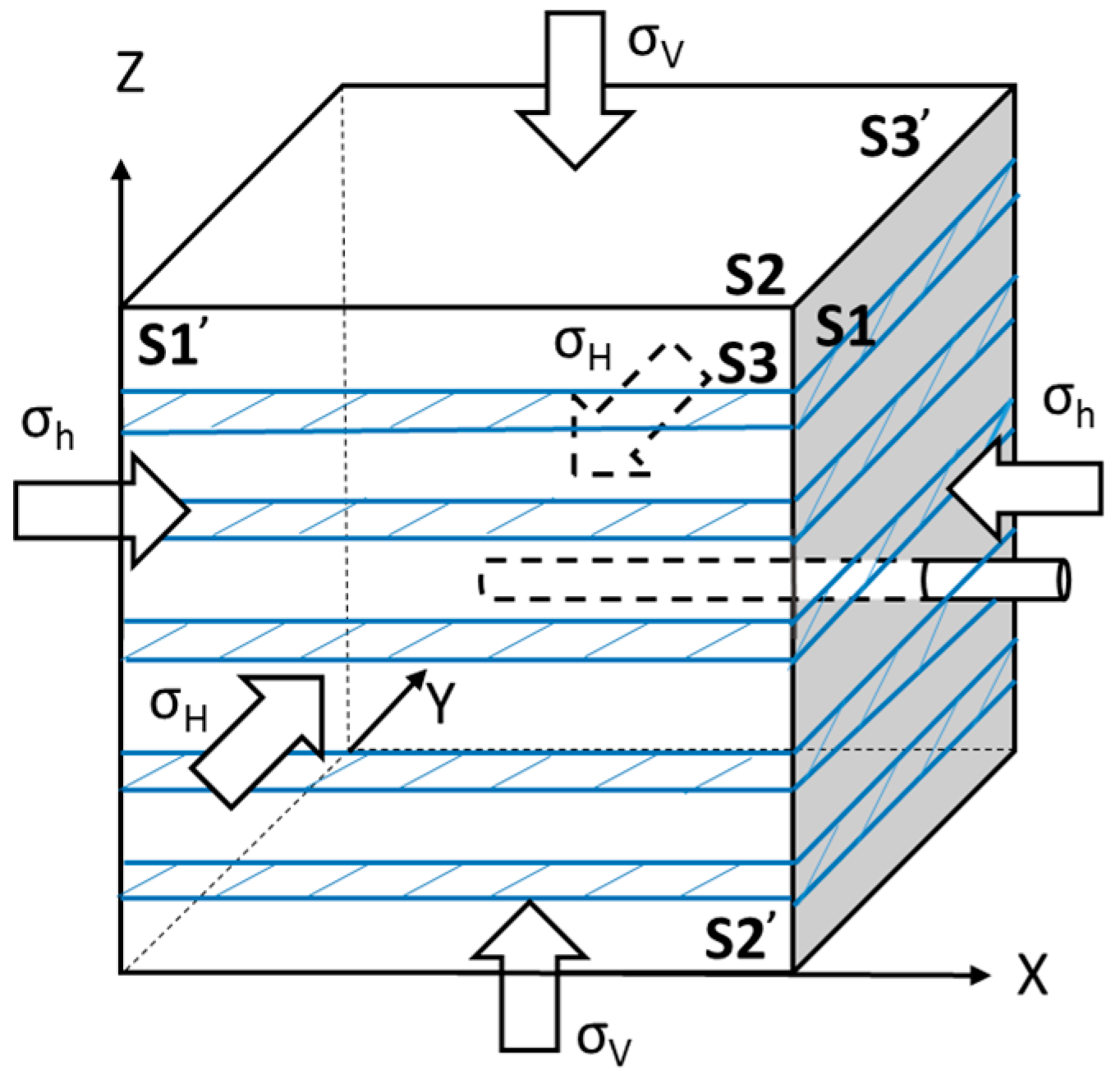

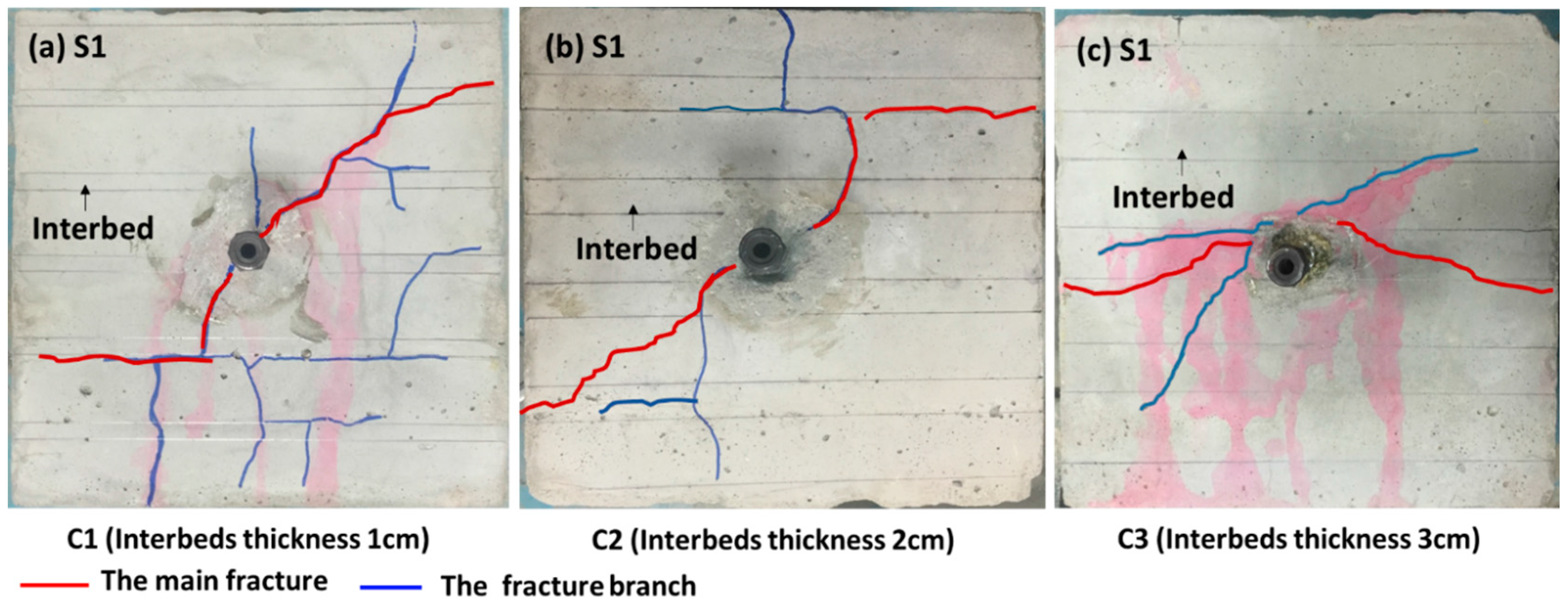
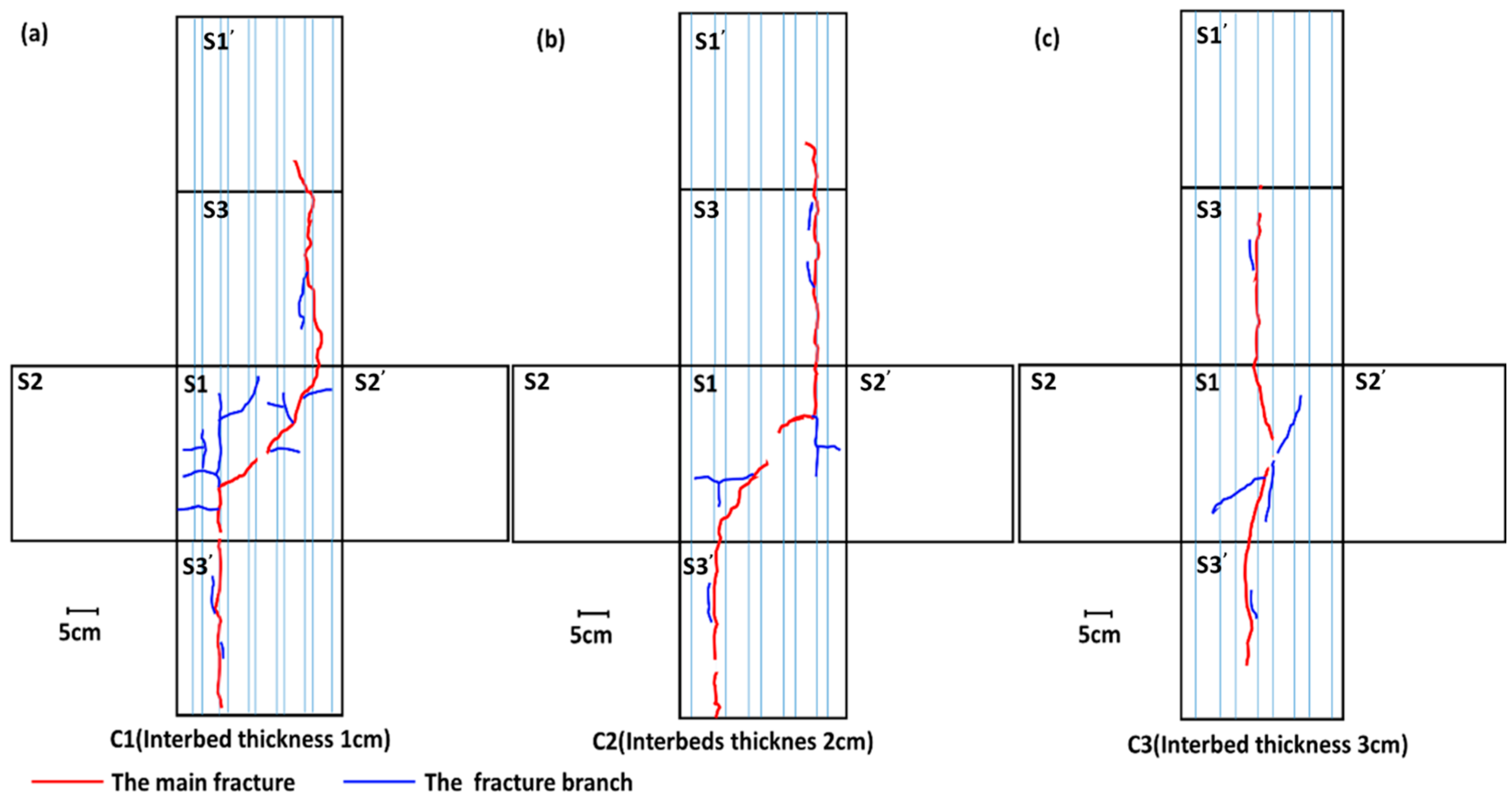
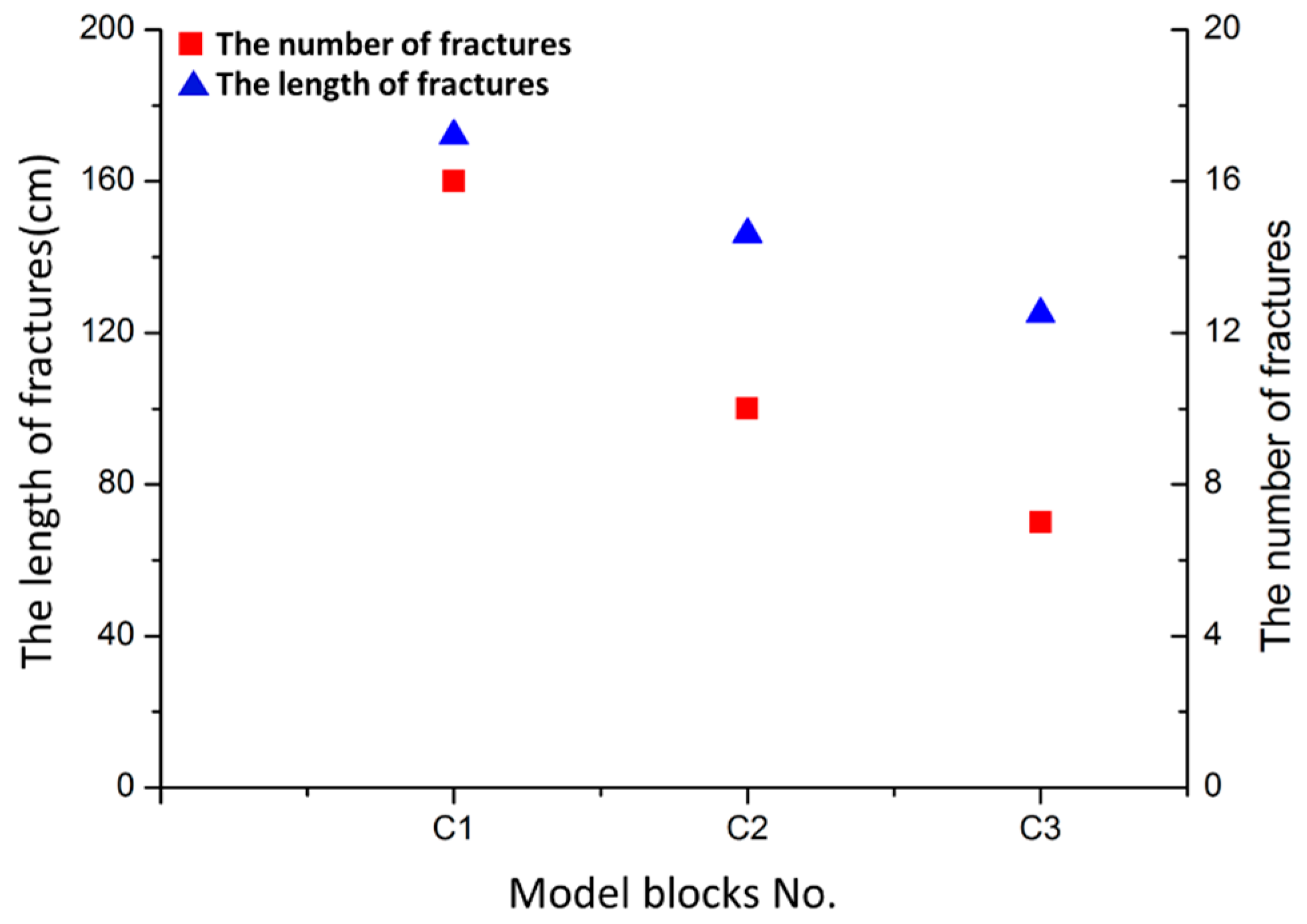
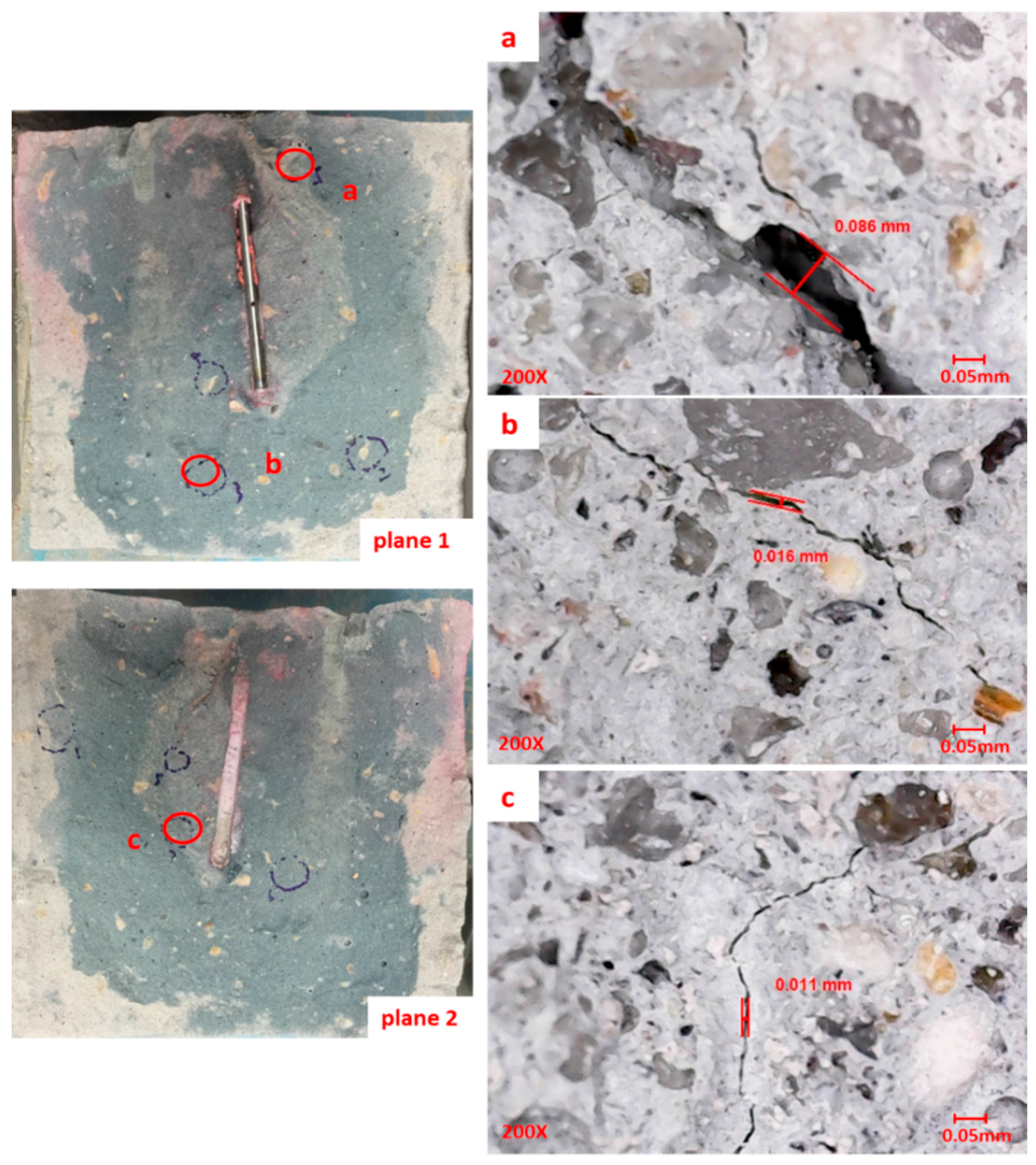
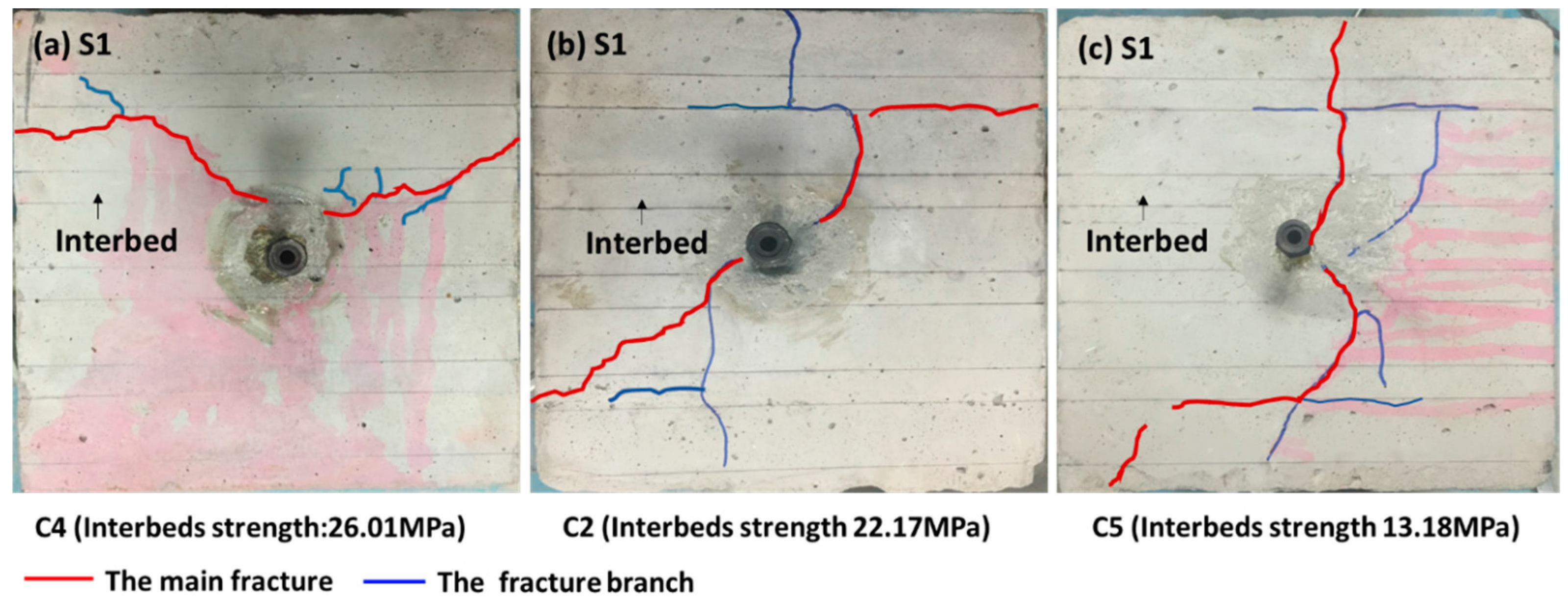
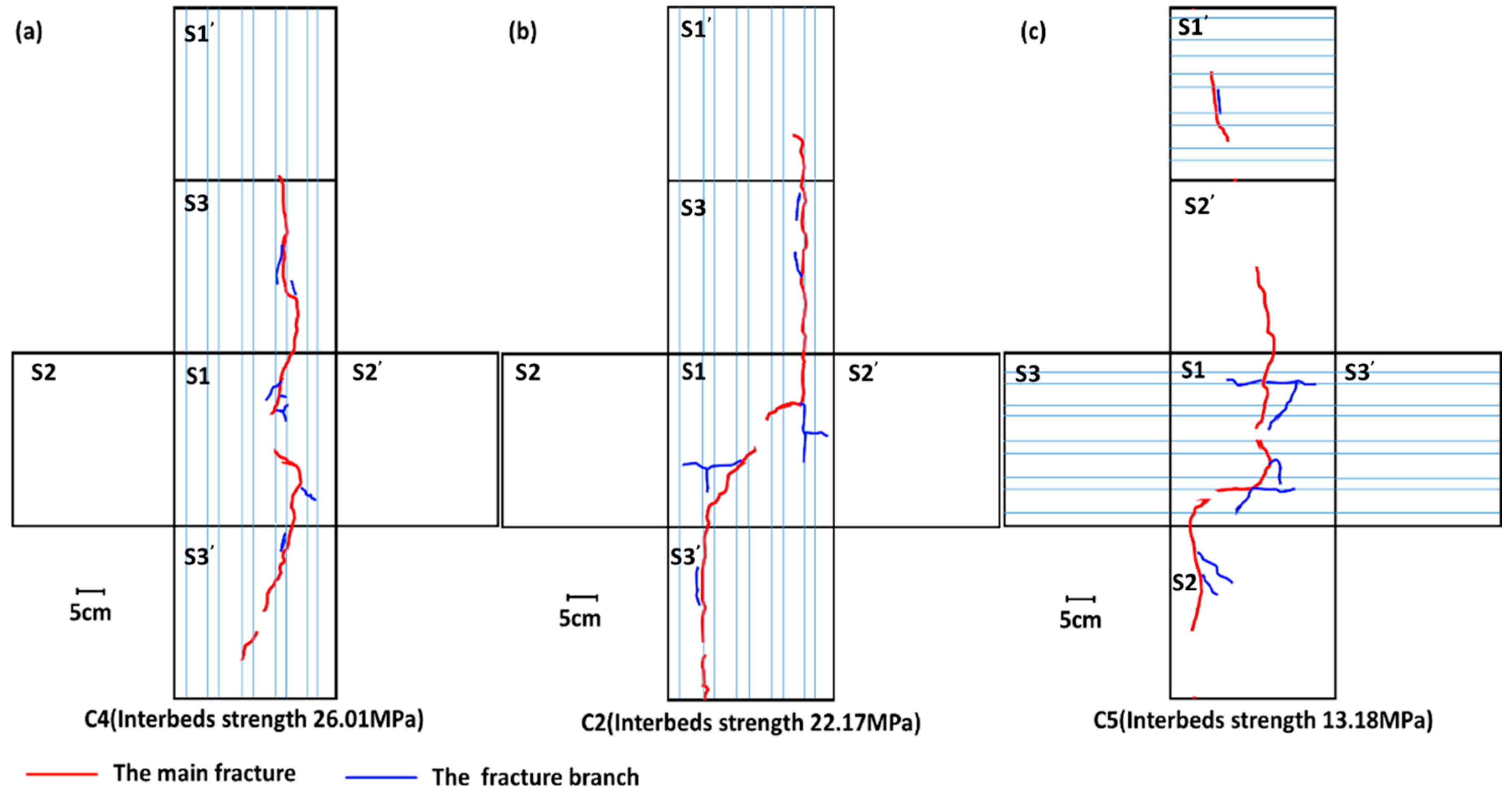
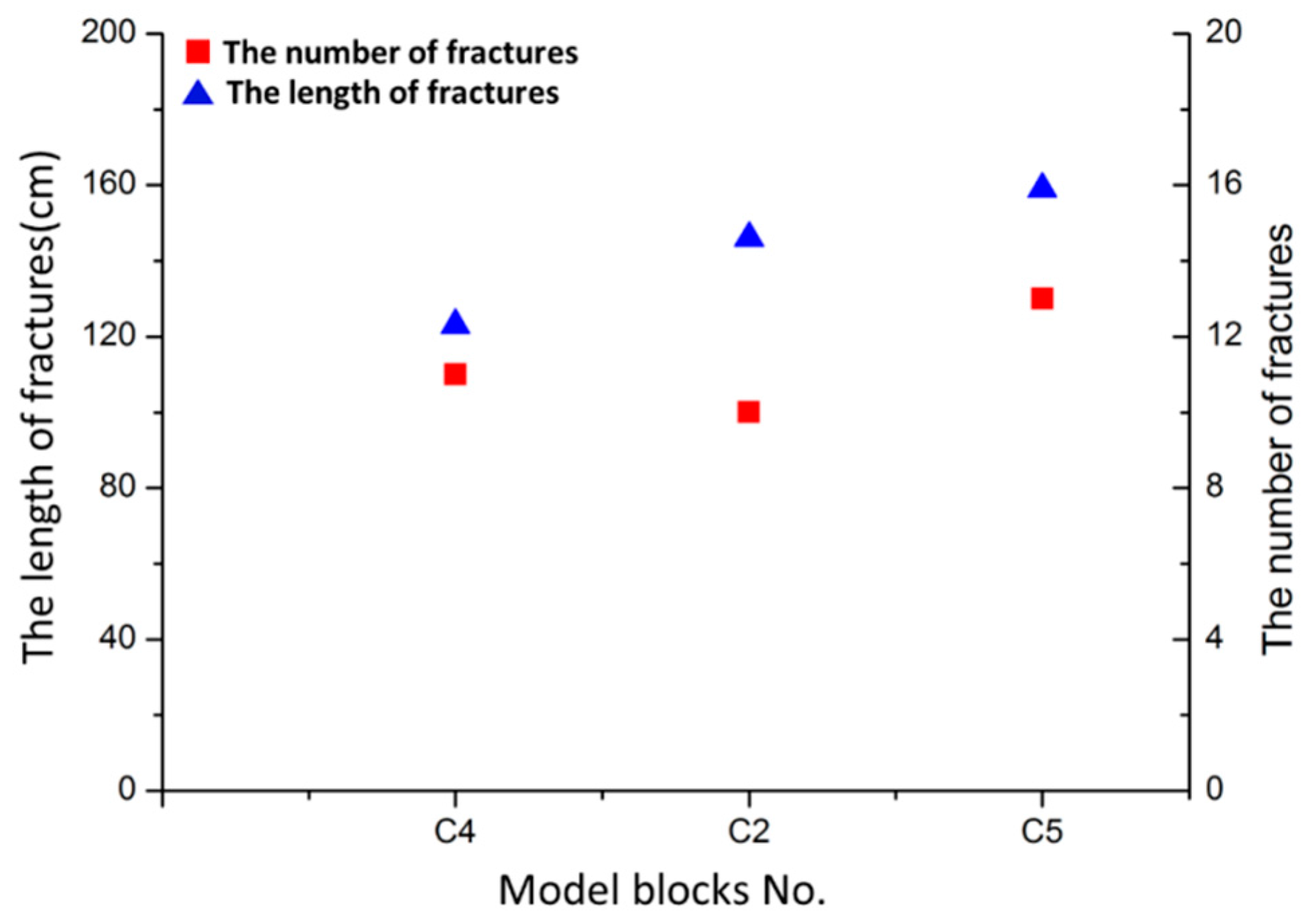
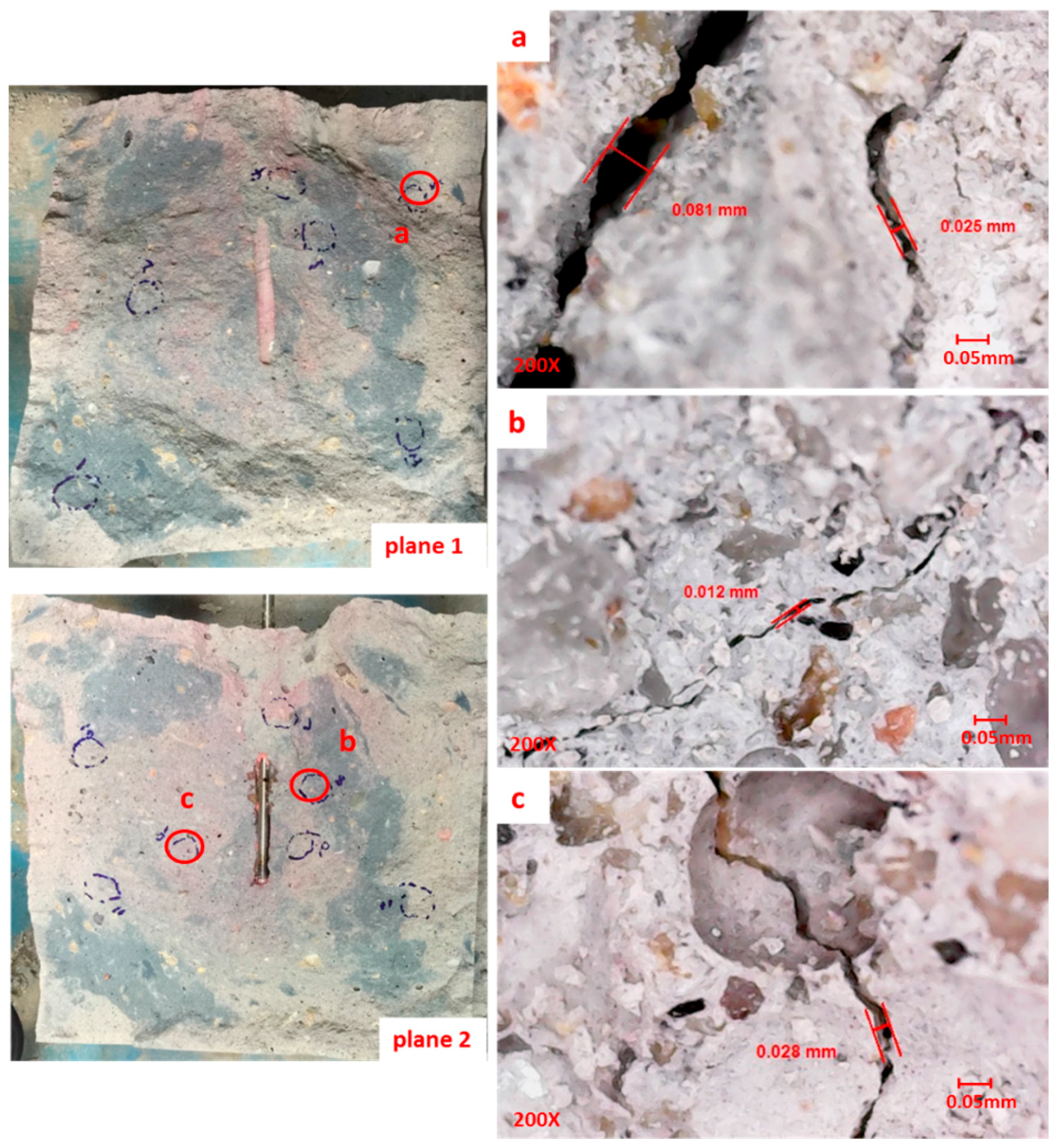
| Model Block No. | Layers No. | Thickness (cm) | C:S:W (mass ratio) | Average UCS (MPa) | Average Tensile Strength (MPa) | Average Young Modulus (GPa) | Average Poisson Ratio |
|---|---|---|---|---|---|---|---|
| C1 | A | 4 | 1:3:0.5 | 33.65 | 3.43 | 30.78 | 0.24 |
| B | 1 | 1:4:0.6 | 22.17 | 2.46 | 26.75 | 0.22 | |
| C2 (Base model) | A | 4 | 1:3:0.5 | 33.65 | 3.43 | 30.78 | 0.24 |
| B | 2 | 1:4:0.6 | 22.17 | 2.46 | 26.75 | 0.22 | |
| C3 | A | 4 | 1:3:0.5 | 33.65 | 3.43 | 30.78 | 0.24 |
| B | 3 | 1:4:0.6 | 22.17 | 2.46 | 26.75 | 0.22 | |
| C4 | A | 4 | 1:3:0.5 | 33.65 | 3.43 | 30.78 | 0.24 |
| B | 2 | 1:2:0.4 | 26.01 | 4.01 | 22.54 | 0.27 | |
| C5 | A | 4 | 1:3:0.5 | 33.65 | 3.43 | 30.78 | 0.26 |
| B | 2 | 1:6:0.7 | 13.78 | 2.01 | 17.76 | 0.20 |
| Model Block No. | Layers No. | Thickness (cm) | C:S:W (Mass Ratio) | Bedding Face Friction Coefficient | Bedding Face Cohesion (MPa) |
|---|---|---|---|---|---|
| C1 | A | 4 | 1:3:0.5 | 0.46 | 3.23 |
| B | 1 | 1:4:0.6 | |||
| C2 (Base model) | A | 4 | 1:3:0.5 | 0.46 | 3.23 |
| B | 2 | 1:4:0.6 | |||
| C3 | A | 4 | 1:3:0.5 | 0.46 | 3.23 |
| B | 3 | 1:4:0.6 | |||
| C4 | A | 4 | 1:3:0.5 | 0.41 | 4.43 |
| B | 2 | 1:2:0.4 | |||
| C5 | A | 4 | 1:3:0.5 | 0.52 | 2.66 |
| B | 2 | 1:6:0.7 |
| Fracturing Fluid | Flow Rate (mL/min) | Stress Condition (MPa) | Horizontal Stress Difference (MPa) | ||
|---|---|---|---|---|---|
| σH | σh | σv | |||
| Water | 50 | 2.1 | 1 | 2.9 | 1.1 |
© 2016 by the authors; licensee MDPI, Basel, Switzerland. This article is an open access article distributed under the terms and conditions of the Creative Commons Attribution (CC-BY) license (http://creativecommons.org/licenses/by/4.0/).
Share and Cite
Zhao, Z.; Li, X.; Wang, Y.; Zheng, B.; Zhang, B. A Laboratory Study of the Effects of Interbeds on Hydraulic Fracture Propagation in Shale Formation. Energies 2016, 9, 556. https://doi.org/10.3390/en9070556
Zhao Z, Li X, Wang Y, Zheng B, Zhang B. A Laboratory Study of the Effects of Interbeds on Hydraulic Fracture Propagation in Shale Formation. Energies. 2016; 9(7):556. https://doi.org/10.3390/en9070556
Chicago/Turabian StyleZhao, Zhiheng, Xiao Li, Yu Wang, Bo Zheng, and Bo Zhang. 2016. "A Laboratory Study of the Effects of Interbeds on Hydraulic Fracture Propagation in Shale Formation" Energies 9, no. 7: 556. https://doi.org/10.3390/en9070556





